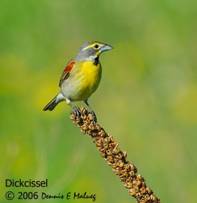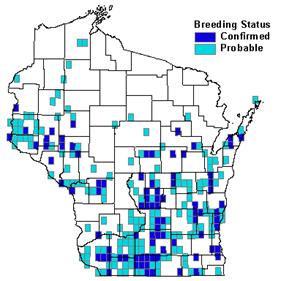Photo by Dennis Malueg


Status/Protection
- Global Rank: G5 Key to global and state ranks
- State Rank: S3B
- WBCI Priority: SGCN, PIF, State Special Concern
Population Information
Federal BBS information can be obtained at http://www.mbr-pwrc.usgs.gov/bbs/bbs.html by clicking on Trend Estimates and selecting the species in question. All estimates are for 1966-2005.
*Note: There are important deficiencies with these data. These results may be compromised by small sample size, low relative abundance on survey route, imprecise trends, and/or missing data. Caution should be used when evaluating this trend.
- Federal Breeding Bird Survey: non-significant decline
- Federal Breeding Bird Survey (WI): significant decline
- Federal Breeding Bird Survey (BCR 23): significant decline
- Federal Breeding Bird Survey (BCR 12): non-significant decline*
- WSO Checklist Project: significant inverted u-shaped quadratic trend (1983-2007)
Life History
- Breeding Range: Saskatchewan south to Texas east across midwestern states (Temple 2002).
- Breeding Habitat: Fallow Field, Dry Prairie, Dry-mesic Prairie, Wet-mesic Prairie, Idle Cool-season Grasses, Idle Warm-season Grasses, Hay, Oak Opening.
- Nest: Near ground in dense grasses and forbs (Temple 2002).
- Nesting Dates: Eggs: late May to early Aug (Robbins 1991).
- Foraging: Ground glean.
- Migrant Status: Neotropical migrant.
- Habitat use during Migration: Large open fields or wetlands with lots of seeds (grasses and small grains).
- Arrival Dates: Late May.
- Departure Dates: August.
- Winter Range: Concentrated in the Ilanos region of central Venezuela (Temple 2002).
- Winter Habitat: Open grasslands, savannas, and croplands.
Habitat Selection
The Dickcissel is a specialist of grasslands that contain dense cover and moderate to tall vegetation (25-150 cm) such as fallow fields, hayfields, and restored grasslands (Sample and Mossman 1997, Temple 2002). Dickcissels prefer areas with significant forb content and will tolerate up to 5% shrubs used for song perches (Sample and Mossman 1997, Dechant et al. 2003). While they may be found in small tracts (Sample and Mossman 1997), this species is found in greater density and is a more successful nester in larger tracts (>10 ha) (Temple 2002, Dechant et al. 2003).
Habitat Availability
Dickcissels are commonly found in grassland habitats within the southern half of Wisconsin. Like most other grassland species, habitat availability has dwindled with increasing agricultural intensification, woodland succession, and rural/urban development. Dickcissels prefer grasslands with low grass:forb ratios (Sample and Mossman 1997) and often use fallow fields adjacent to development or “business parks” on the edges of urban areas. While these areas provide temporary refuge, they don’t provide suitable long-term habitat.
Population Concerns
Historically, Dickcissels were only found in the southern counties of Wisconsin. Like many other grassland birds adapted to agriculture, their range expanded north in the past 100 years with the spread of agriculture. In Wisconsin and elsewhere, Dickcissels are prone to erratic shifts in population and irruptive behavior (Robbins 1991). During the six-year period (1995-2000) of the Wisconsin Breeding Bird Atlas, observers confirmed breeding in approximately 8% of the surveyed quads (Sample 2006). Breeding bird surveys indicated a sharp population decline from 1966-1979, where it then seems to have stabilized at two-thirds the 1966 level (Sauer et al. 2005).
One contributing factor to their population decline may be the early mowing of hayfields, which can lead to very high rates of nest failure (Igl 1991). High mortality on the wintering grounds also is a significant threat. Farmers in Venezuela deliberately kill Dickcissels with toxic agricultural chemicals to prevent them from feeding on ripening grain crops. The Dickcissel’s propensity to form large roosting flocks means that thousands of birds can be killed at a single location (Temple 2002).
Recommended Management
Management should focus on providing medium to tall vegetation with a significant component of forbs (Sample and Mossman 1997). Burning, mowing, or grazing can provide suitable Dickcissel habitat by controlling succession (Dechant et al. 1999), but should be conducted after the breeding season (mid-August) (Sample and Mossman 1997). The Conservation Reserve Program (CRP) grasslands provide important breeding habitat for Dickcissels in some parts of their range (Dechant et al. 1999). Hull et al. (1996) found Dickcissel abundance higher in CRP fields with a high occurrence of forbs. On the wintering grounds, major conservation efforts are necessary to control the large-scale, illegal killing of this species (Temple 2002).
Conservation and management strategies for this species should be focused in the following Wisconsin ecological landscapes: Southwest Savanna, Western Prairie, and Central Sand Hills (WDNR 2005). Within these landscapes, the best public lands to manage for midgrass species, such as the Dickcissel, are Thomson Prairie Grasslands, Star Prairie Pothole Grasslands, and Muralt/Monroe Grasslands.
Research Needs
Research is needed into the hypothesis that Dickcissels raise a second brood in the northern part of their range after a first brood in the southern part of their range. If true, this would have important implications on estimating annual productivity and understanding population dynamics (Temple 2002).
Information Sources
- Knutson, M.G., G. Butcher, J. Fitzgerald, and J. Shieldcastle. 2001. Partners in Flight Bird Conservation Plan for The Upper Great Lakes Plain (Physiographic Area 16). USGS Upper Midwest Environmental Sciences Center in cooperation with Partners in Flight. La Crosse, WI.
- Managing Habitat for Grassland Birds: A Guide for Wisconsin: http://www.npwrc.usgs.gov/resource/birds/wiscbird/
- North American Breeding Bird Survey: http://www.npwrc.usgs.gov
- Temple S.A., J.R. Cary, and R. Rolley. 1997. Wisconsin Birds: A Seasonal and Geographical Guide. Wisconsin Society of Ornithology and Wisconsin Department of Natural Resources, Madison, WI.
- Wisconsin Breeding Bird Atlas: http://www.uwgb.edu/birds/wbba/
- David Sample, Grassland Community Ecologist, Wisconsin DNR - 608-221-6351
References
- Dechant, J.A., M.L. Sondreal, D.H. Johnson, L.D. Igl, C.M. Goldade, A.I. Zimmerman, and B.R. Euliss. 1999. Effects of management practices on grassland birds: Dickcissel. Northern Prairie Wildlife Research Center, Jamestown, ND. 27pp.
- Hull, S.D., R.J. Robel, and K.E. Kemp. 1996. Summer avian abundance, invertebrate biomass, and forbs in Kansas CRP. Prairie Naturalist 28:1-12.
- Igl, L.D. 1991. The role of climate and mowing on Dickcissel (Spiza americana) movements, distribution and abundance. M.S. thesis. Iowa State University, Ames, Iowa. 54pp.
- Robbins, S.D., Jr. 1991. Wisconsin Birdlife: Population and distribution past and present. Madison, WI: Univ. Wisconsin Press.
- Sample, D. and M. Mossman. 1997 Managing Habitat for Grassland Birds: A Guide for Wisconsin. Wisconsin Department of Natural Resources: Madison, WI.
- Sample, D. 2006. Dickcissel. In Atlas of the Breeding Birds of Wisconsin. (N.J. Cutright, B.R. Harriman, and R.W. Howe, eds.). The Wisconsin Society for Ornithology, Inc. 602pp.
- Sauer, J.R., J.E. Hines, and J. Fallon. 2005. The North American Breeding Bird Survey, Results and Analysis 1966 - 2005. Version 6.2.2006. USGS Patuxent Wildlife ResearchCenter, Laurel, MD.
- Temple, S.A. 2002. Dickcissel (Spiza americana). In The Birds of North America, No. 703 (A. Poole and F. Gill, eds.). The Birds of North America, Inc., Philadelphia, PA.
- Wisconsin Department of Natural Resources (WDNR). 2005. Wisconsin’s Strategy for Wildlife Species of Greatest Conservation Need. Madison, WI.
Contact Information
- Compiler: Jenny Herrmann, mherrmann4@wi.rr.com
- Editor: Dave Sample, David.Sample@Wisconsin.gov | Kim Kreitinger, K.Kreitinger@gmail.com
